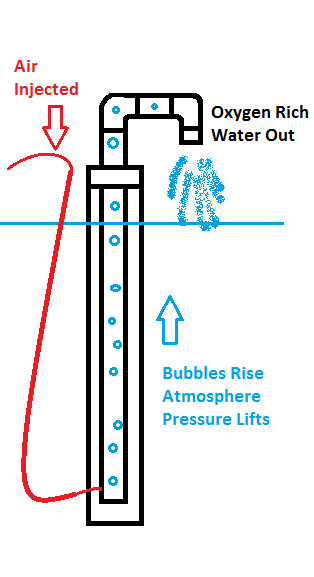 An air lift is using air bubbles in a pipe to lift water. The deeper you start the bubbles, the more water you can lift, but the more PSI required on the air pump.
An air lift is using air bubbles in a pipe to lift water. The deeper you start the bubbles, the more water you can lift, but the more PSI required on the air pump.
The air lifts the water and it flows out of the top. Air lifts are extremely energy efficient, but not as strong as a regular pump.
Air lifts can only raise water as high as the surrounding submerged “lift”. For example, if you wanted to lift a 2″ PVC column of water 3 feet above the water table, you would need at least 3 feet of water UNDER the water table to introduce air.
Airlifts generally have a low suction and will not suck up fish. Head height is the major limiting factor.
A major advantage besides the energy efficiency is the reliability of the air lift system. Gravel and other objects can be sucked up without damage to the pumping equipment.
In a commercial aquaponics system a large and powerful air pump and provide air to multiple air lifts throughout the complex, saving money, maintenance and energy multiple times.
To repair a typical air pump requires only a diaphragm, which is usually less than several dollars and lasts a year or more.
If you needed to lift the water higher, you could dig a small well next to the tank, and force air at the very bottom of the well to rise through several feet of pipe.
Every 3 feet of water depth requires about 1 PSI on the pump. A typical 25 Watt air pump can move 350 to 500 gph of water and lift it a few feet, where a traditional pump that does the same thing might require 100 watts or more.
Air lifts also highly oxygenate the water, for no additional energy cost, whereas traditional pumps require excess power to introduce high DO content.
{ 0 comments… add one }
Next post: Geyser Pump
Previous post: Aquaponics Glossary: Aquaculture